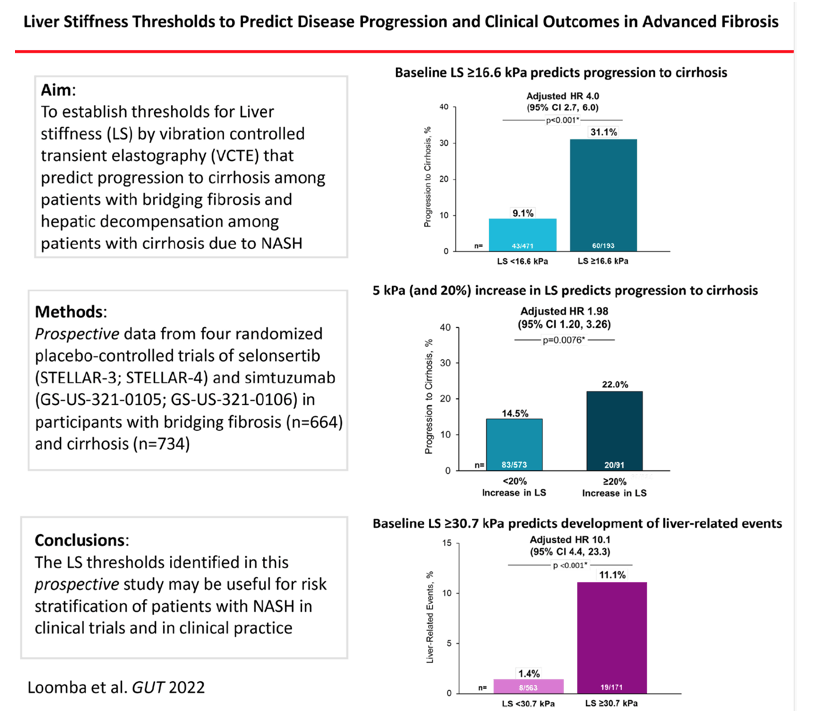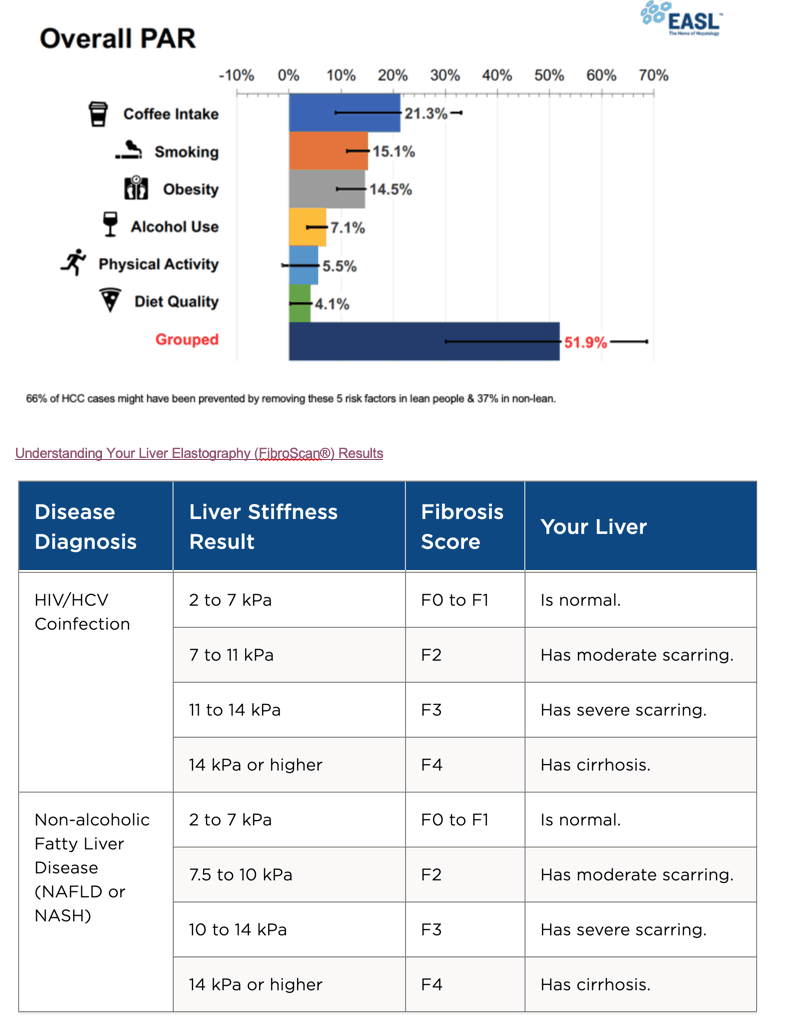| |
(Fibroscan) Liver stiffness thresholds to predict disease
progression and clinical outcomes in bridging fibrosis and cirrhosis [with NASH]
|
| |
| |
Download the PDF here
Effects of tesamorelin on non-alcoholic fatty liver disease
in HIV: a randomised, double-blind, multicentre trial
EASL: Semaglutide 2.4 mg once weekly improved liver and metabolic parameters, and was well tolerated, in patients with non-alcoholic steatohepatitis-related cirrhosis: a randomised, placebo-controlled phase 2 trial - (07/01/22)
EASL: NAFLD Pipeline - by Rohit Loomba MD - (07/21/22)
Tesamorelin Improves Fat Quality Independent of Changes in Fat Quantity
Tesamorelin, liver fat, and NAFLD in the setting of HIV
Abstract
Objective In retrospective studies, liver stiffness (LS) by vibration-controlled transient elastography (VCTE) is associated with the risk of liver decompensation in patients with non-alcoholic steatohepatitis (NASH), but prospective data in biopsy-confirmed cohorts with advanced fibrosis are limited. We aimed to establish thresholds for LS by VCTE that predict progression to cirrhosis among patients with bridging fibrosis and hepatic decompensation among patients with cirrhosis due to NASH.
Design We used data from four randomised placebo-controlled trials of selonsertib and simtuzumab in participants with advanced fibrosis (F3-F4). The trials were discontinued due to lack of efficacy. Liver fibrosis was staged centrally at baseline and week 48 (selonsertib study) or week 96 (simtuzumab study). Associations between LS by VCTE with disease progression were determined using Cox proportional hazards regression analysis.
Results Progression to cirrhosis occurred in 16% (103/664) of participants with bridging fibrosis and adjudicated liver-related events occurred in 4% (27/734) of participants with baseline cirrhosis.
The optimal baseline LS thresholds were ≥16.6 kPa for predicting progression to cirrhosis, and ≥30.7 kPa for predicting liver-related events.
Baseline LS ≥16.6 kPa (adjusted HR 3.99; 95% CI 2.66 to 5.98, p<0.0001) and a ≥5 kPa (and ≥20%) increase (adjusted HR 1.98; 95% CI 1.20 to 3.26, p=0.008) were independent predictors of progression to cirrhosis in participants with bridging fibrosis, while baseline LS ≥30.7 kPa (adjusted HR 10.13, 95% CI 4.38 to 23.41, p<0.0001) predicted liver-related events in participants with cirrhosis.
Conclusion The LS thresholds identified in this study may be useful for risk stratification of NASH patients with advanced fibrosis.

Out of the 664 participants with bridging fibrosis, 103 (16%) progressed to cirrhosis. Among the 734 patients with cirrhosis, 27 (4%) experienced liver-related events. Comparing these outcomes with LS data at baseline and throughout the study revealed optimal LS thresholds.
The best threshold for predicting progression from bridging fibrosis to cirrhosis was 16.6 kPa. According to the authors, the sensitivity, specificity, positive predictive value, and negative predictive value of this threshold for progression to cirrhosis were 58%, 76%, 31%, and 91%, respectively. Among patients at or above 16.6 kPa, 31% progressed to cirrhosis, compared with 9.1% of those under that threshold. Furthermore, individuals with a baseline LS at or above 16.6 kPa had nearly four times greater risk of developing cirrhosis (adjusted hazard ratio, 3.99; 95% CI, 2.66¬-5.98; P < .0001).
For patients with cirrhosis at baseline, the optimal threshold for predicting liver-related events, such as ascites, hepatic encephalopathy, and portal hypertension-related GI bleeding, liver transplantation, or mortality, was 30.7 kPa. The sensitivity, specificity, PPV, and NPV of this threshold for liver-related events were 62%, 87%, 10%, and 99%, respectively, according to the authors. Patients with an LS above this mark were 10 times as likely to experience liver-related events (aHR, 10.13; 95% CI, 4.38-23.41; P < .0001).
The LS thresholds identified in this study may be useful for risk stratification of patients with NASH in clinical trials and in clinical practice and screening fir liver cancer.
Lifestyle Changes That Improve Preventing HCC
Drinking 2 or more cups of coffee daily cut risk of hepatocellular carcinoma (HCC) 30% in an ethnically diverse 181,346-person US cohort [1]. In lean people, downing more than 2 cups of java daily halved HCC risk. This study of a California-Hawaii cohort also found that obesity boosted HCC risk by two thirds, while smoking tripled the risk.
66% of HCC cases might have been prevented by removing these 6 risk factors in lean people & 37% in non-lean.
 Understanding Your Liver Elastography (FibroScan®) Results
Understanding Your Liver Elastography (FibroScan®) Results
|
|
| |
| |
|
|
|